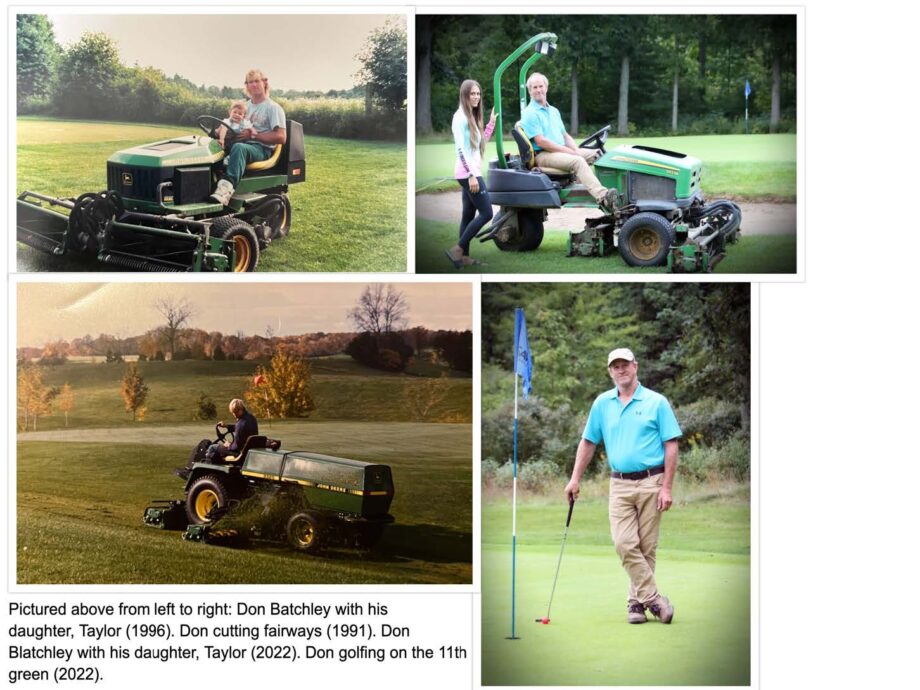Written by: Taylor Blatchley
There is a reason the term superintendent includes the word “super.” Golf course
superintendents often work behind the scenes, which usually results in them not getting enough credit for their work. On September 13th, it is “Thank a Golf Course Superintendent Day,” where we recognize the hard work it takes to keep golf
work of superintendents across the nation can be celebrated and appreciated by all.
Don Blatchley is the superintendent of Sawmill Golf Course and has worked there for 42
years. He started working there in 1979. I interviewed him on his role as a
superintendent and how it has changed and developed over the years.
How did you get into this line of work?
Don: My family golfed at Sawmill, and I asked George for a job when I was out of high
school.
#ThankASuper
Which part of being a superintendent do you find most satisfying?
Don: That moment when people approach you and comment on the condition and
quality of the golf course. When you change something, no matter how small or large,
and people notice. That’s the best part.

Which part of being a superintendent do you find most challenging?
Don: Making sure the greens, tees and bunkers are in the best shape possible.
Especially the greens because they are the heart of the entire course. If the greens are
not in perfect condition, people will know. New challenges exist now that didn’t exist a
few years ago. You have to keep adapting as the environment and conditions change.
What was it like working as a superintendent in the 1970s, compared to the 1990s
and present time in 2022? How has it changed?
Don: The main difference I can think of is the technology available. In the 1970s and
early 1980s, all your fertilizer and fungicide were granular. Now, it is all spray based. The
only sprayer we had back then was tractor-mounted. Technology has advanced through
the years to the point where the current sprayers are computerized and regulate
and control the amount of spray they put out. The equipment used now at golf courses
drastically reduces the time required to perform tasks. Back in the day, top
dressing the greens would take us around a week to do, and now we can do it in less
than a day. All of the equipment has changed from when I started. Fairway mowers,
rough mowers, and greens mowers are all more advanced and designed for maximum
efficiency. The only downside to better technology is that when something goes wrong,
it takes longer to fix it, or you may need to call in a specialist because of the electronics
involved. Irrigation used to be done manually as well. I would spend hours at night
watering, whereas now everything is automated and all I have to do is click a few keys
on the computer. The course itself looks very different too. Bunkers have been added
and removed, and I’m pretty sure there isn’t a single bunker in its original location. The
same applies to the tee decks. As for the trees, let’s just say that I used to be able to
see the clubhouse from the shop, and now I can’t. In the 1970s, they were just twigs
sticking out of the ground.
What was the most difficult on-course situation you’ve ever faced at Sawmill?
Don: Snow mould on the fourth green. This was a long time ago, the winter was long,
and we could not get snow mould protection down early enough because the golf
season ended so abruptly, and the snow stayed on the ground. We did not have the
equipment available to aerate; all we could do was put new plugs into the affected
areas. I’m not talking about a few patches here and there. What I’m talking about is
hundreds of plugs. I don’t even remember exactly where we got the plugs from because
it was so long ago. But that was one of the most difficult situations I remember having to
handle.
If you could give one piece of advice to anyone wanting to get into golf course
work, what would you say?
Don: Make sure you’re passionate about it. A lot of times, the work will seem like it is
twenty-four seven. Issues have a way of suddenly appearing at the worst time possible.
Usually at the beginning or end of the week and never in the middle. Sometimes you’ll
have to drop everything to deal with a golf course situation, which is how it is.
There could be a broken irrigation line during a drought, disease on the greens or a
pump that breaks down, leading to you hand watering for a week straight. Some things
just can’t wait until the following day. It’s challenging but rewarding work; if you love
what you do, it’s worth it.
What is your passion or favourite hobby?
Don: Golf.
What’s your favourite sports team or individual?
Don: Toronto Maple Leafs
What do you like to watch on TV?
Don: Nascar. I used to watch it a lot more than I do now because all the good drivers
are retired.
What is your favourite thing about working at Sawmill?
Don: The people and the owners. The owners have always treated me like family; some of the members have been there as long as I’ve been working there, so it’s a real
family environment.
Remember to use the hashtag #ThankASuper today on social media and show your
appreciation for our golf course superintendents.




